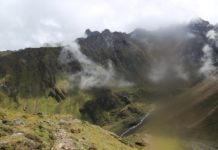Rainfall can contribute in moving mountains, findings by researchers from the University of Bristol shows. These findings can not only enable geologists to effectively study the impact rain has on mountains, but also the process that has led to the development of peaks and valleys over a period of hundreds of years.
Published in the peer-reviewed journal Science Advances, the study titled ‘Climate controls on erosion in tectonically active landscapes’ was conducted by a team of researchers led by Dr Byron Adams. For its research, the team from the University of Bristol conducted a study in the central and eastern part of the Himalayas falling in Bhutan and Nepal.

A Royal Society Dorothy Hodgkin fellow at the University of Bristol’s Cabot Institute for the Environment, Dr Byron Adams collaborated with researchers from the Arizona State University (ASU) and Louisiana State University for the study. They used cosmic clocks within sand grains to measure the speed at which rivers erode the rocks underneath them.
The objective of the study was to study the impact of the climate on tectonics. “This study complements and improves upon previous work by combining the range of relief, rainfall, and erosion rates usually found only in a global study with the careful curation of data to ensure that only truly comparable, quasi-equilibrium catchments are considered that is usually only possible in local studies,” the study published in Science Advances says.

The lead author of this study, Dr Byran Adams said the team tested a number of numerical models to reproduce the observed “erosion rate patter” across Bhutan and Nepal. Once they managed to identify the one model that could accurately predict the measured erosion rates, researchers used this model to quantify how rainfall affects “erosion rates in rugged terrain”.





















